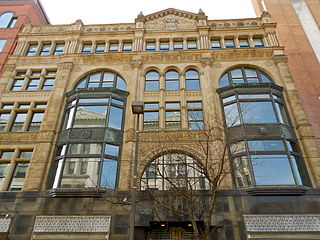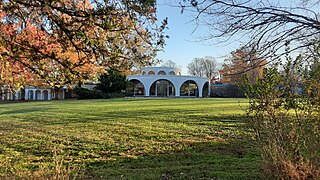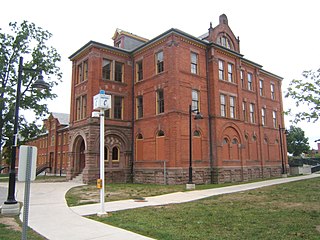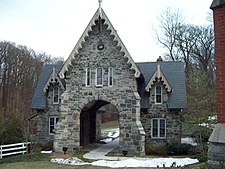
The Enoch Pratt Free Library is the free public library system of Baltimore, Maryland. Its Central Library and office headquarters are located on 400 Cathedral Street (southbound) and occupy the northeastern three quarters of a city block bounded by West Franklin Street to the north, Cathedral Street to the east, West Mulberry Street to the south, and Park Avenue (northbound) to the west. Located on historic Cathedral Hill, north of downtown, the library is also in the Mount Vernon-Belvedere-Mount Royal neighborhood and cultural and historic district.

Enoch Pratt was an American businessman in Baltimore, Maryland. Pratt was also a committed active Unitarian, and a philanthropist. He is best known for his donations to establish the Enoch Pratt Free Library in Baltimore and expanding the former Sheppard Asylum to become The Sheppard and Enoch Pratt Hospital,, located north of the city in western Towson, county seat of Baltimore County. Born and raised in Massachusetts, he moved south to the Chesapeake Bay area and became devoted to the civic interests of the city of Baltimore. He earned his fortune as an owner of business interests beginning in the 1830s originally as a hardware wholesaler, and later expanding into railroads, banking and finance, iron works, and steamship lines and other transportation companies.

Moses Sheppard was a Baltimore businessman, a Friend (Quaker), a philanthropist, and founder of the now Sheppard and Enoch Pratt Hospital.

Claybury Hospital was a psychiatric hospital in Woodford Bridge, London. It was built to a design by the English architect George Thomas Hine who was a prolific Victorian architect of hospital buildings. It was opened in 1893 making it the Fifth Middlesex County Asylum. Historic England identified the hospital as being "the most important asylum built in England after 1875".

The Institute of Pennsylvania Hospital, also known as Kirkbride's Hospital or the Pennsylvania Hospital for Mental and Nervous Diseases, was a psychiatric hospital located at 48th and Haverford Streets in Philadelphia, Pennsylvania, USA. It operated from its founding in 1841 until 1997. The remaining building, now called the Kirkbride Center is now part of the Blackwell Human Services Campus.

The Trans-Allegheny Lunatic Asylum, subsequently the Weston State Hospital, was a Kirkbride psychiatric hospital that was operated from 1864 until 1994 by the government of the U.S. state of West Virginia, in the city of Weston. Weston State Hospital got its name in 1913 which was used while patients occupied it, but was changed back to its originally commissioned, unused name, the Trans-Allegheny Lunatic Asylum, after being reopened as a tourist attraction.

The Kalamazoo Psychiatric Hospital (KRPH) is the largest mental health institution in Michigan. It was built under the Kirkbride Plan.
Thomas Dixon was a Presbyterian architect born in Wilmington, Delaware and one of the founders of the Baltimore chapter of AIA. He was the father of minister Thomas Freeman Dixon, an 1893 graduate of Princeton Theological Seminary. He partnered with his brother, James M. Dixon, from 1851 until James's death in 1863. In 1871, he partnered with another well-known Baltimore architect Charles L. Carson for some time doing business from their offices at 117 Baltimore Street as Thomas Dixon and Charles L. Carson until sometime before 1877 when the partnership was dissolved. In 1827, he was elected Honorary Academician at the National Academy of Design.

The Brattleboro Retreat is a private not-for-profit mental health and addictions hospital that provides comprehensive inpatient, partial hospitalization, and outpatient treatment services for children, adolescents, and adults.
Otto Eugene Adams (Sr.), the architect, was born in Baltimore, Maryland, on November 1, 1889, to a family with Baltimore and German ancestry.

Kew Lunatic Asylum is a decommissioned psychiatric hospital located between Princess Street and Yarra Boulevard in Kew, a suburb of Melbourne, Australia. Operational from 1871 to 1988, Kew was one of the largest asylums ever built in Australia. Later known as Willsmere, the complex of buildings were constructed between 1864 and 1872 to the design of architects G.W. Vivian and Frederick Kawerau of the Victorian Public Works Office to house the growing number of "lunatics", "inebriates", and "idiots" in the Colony of Victoria.

Auburn House is a historic home located on the grounds of Towson University in Towson, Baltimore County, Maryland, United States. It was built in 1790 by Charles Ridgely III and stayed in the family until it became part of the Sheppard and Enoch Pratt Hospital property in 1944. Towson University acquired it in 1971.
Aigburth Vale house at 212 Aigburth Road in Towson was designed in 1868, by architects Niernsee & Neilson, as a country home for wealthy actor John E. Owens.

Baldwin & Pennington was the architectural partnership with Ephraim Francis Baldwin (1837–1916) and Josias Pennington (1854–1929) based in Baltimore, Maryland. The firm designed an incredibly large number of prominent structures throughout the Middle Atlantic region, especially as the "house architects" of the Baltimore and Ohio Railroad, including many of its stations and other late 19th century structures for the railroad. Several of their works are listed on the United States' National Register of Historic Places, maintained by the National Park Service of the U.S. Department of the Interior.
William Rush Dunton Jr was a founder and early president of the American Occupational Therapy Association. He is also recognized for his collection of, and scholarship about, American quilts.

Edward Nathaniel Brush was an American physician, a mental hospital administrator, and an editor of psychiatric journals.

Sheppard Pratt at Ellicott City was a private psychiatric hospital located in Ellicott City, Maryland. It had a 20-bed adult unit, an 18-bed co-occurring disorders unit, an 18-bed crisis stabilization unit, a 22-bed adolescent unit, and an adult day hospital. The hospital was owned and operated by the Towson, Maryland based Sheppard Pratt Health System

The Lakeshore Psychiatric Hospital was a psychiatric hospital located in the town of New Toronto, Ontario. The hospital grounds now form part of Humber College's Lakeshore Campus.
Sheppard Pratt at Elkridge is a private psychiatric hospital under construction in Elkridge, Maryland. The hospital will serve as a replacement location for nearby Sheppard Pratt at Ellicott City.



















